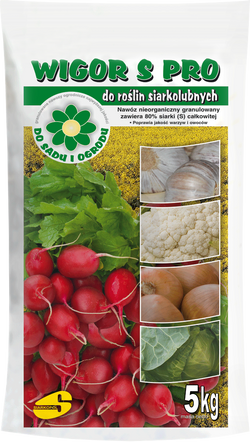- Nawóz „Wigor S Pro” przeznaczony jest do nawożenia gleb wskazujących niedobór siarki, również w celu regulacji kwasowości gleby i do nawożenia roślin siarkolubnych.
Siarka granulowana Vigor S Pro
Nawóz „Wigor S Pro” przeznaczony jest do nawożenia gleb wskazujących niedobór siarki, również w celu regulacji kwasowości gleby i do nawożenia roślin siarkolubnych takich jak: rzepak, groch, rośliny motylkowe, kapustne, burak cukrowy i ćwikłowy, warzywa cebulowate, rzodkiewka, pomidory, dynia, fasola, melon, ogórek, papryka, ziemniaki, a także pszenica, jęczmień i kukurydza oraz rośliny sadownicze i ozdobne. W ogrodnictwie jest szczególnie polecanym nawozem dla różaneczników, borówek, wrzosów i innych roślin kwasolubnych. Wpływa na obniżenie pH gleby wymaganego do prawidłowego wzrostu, a także rozwoju roślin ozdobnych z rodziny wrzosowatych. Nawóz „Wigor S Pro” jest nawozem przedsiewnym. Działa dobrze na glebach o odczynie zasadowym i obojętnym.
Skład nawozu Vigor S
min. 80 % siarki
Właściwości nawozu Vigor S
Zawarty w nawozie bentonit, dzięki swoim właściwościom pęcznienia w kontakcie z wodą, powoduje rozdrobienie siarki, a w efekcie szybsze utleniania przez mikroorganizmy do postaci siarczanowej, przyswajalnej przez rośliny.
Plonotwórcze skutki działania siarki nawozowej ujawniają się poprzez:
Bezpośredni wzrost plonów – siarka zwiększa skuteczność i wydajność nawożenia azotowego ( poprzez lepsze pobieranie i wykorzystanie azotu).
Poprawę jakości plonów:
- Zmniejszenie zawartości azotanów w roślinach warzywnych,
- Wzrost zawartości skrobi w bulwach ziemniaków i sacharozy w korzeniach buraka cukrowego,
- Wzrost zawartości białka w nasionach, do syntezy białek potrzebne są bezwzględnie aminokwasy siarkowe ( cysteina i metionina)
- Poprawia walorów smakowych roślin takich jak: cebula, czosnek, por oraz strączkowe.
Poprawę gospodarki węglowodanami – co pośrednio wywołuje wzrost tolerancji roślin na stresy abiotyczne ( zbyt niskie i wysokie temperatury, niedobór wody).
Sposób i terminy stosowania nawozu Vigor S
Pod rośliny ozime na gruntach ornych nawóz powinien być stosowany pod orkę siewną. W przypadku roślin jarego siewu, czy sadzenia należy stosować go pod orkę zimową, ewentualnie także pod orkę wiosenną. W innych przypadkach zaleca się zmieszanie nawozu z glebą na głębokość do 15 cm.
W uprawach wieloletnich roślin motylkowych nawóz należy stosować zgodnie z zasadami nawożenia tych użytków na wiosnę, przed lub na początku ruszenia wegetacji. Nawóz należy rozsiewać równomiernie na całej powierzchni pola w sposób wykluczający nawożenie pól i upraw do tego nieprzeznaczonych. Nie należy stosować dawek większych niż zalecane.
Nawóz należy stosować w odległości 5-10 cm od rzędu rosnących roślin lub wysianych nasion. Ze względu na zakwaszające działanie powinien być stosowany na gleby o uregulowanym odczynie gleby, zwłaszcza w uprawach roślin wrażliwych na odczyn tj. rzepak, pszenica, borówka wysoka, żurawina. W przypadku upraw borówki wysokiej stosujemy nawóz wzdłuż rzędu roślin o szerokości 60-80 cm, uważając aby nie obsypywać roślin. Najlepiej stosować nawóz przed ruszeniem wegetacji lub po jej zakończeniu ( licząc powierzchnię aplikacji nawozu na podstawie szerokości i długości rzędu roślin). Po zastosowaniu nawóz należy wymieszać z glebą.
Dawkowanie nawozu Vigor S
Rośliny warzywnicze o bardzo dużym zapotrzebowaniu na siarkę ( ze średniej wielkości plonem rośliny te pobierają 40-80 kg S/ha) – polecana dawka 30-50 kg nawozu/ha ( 24-40 kg S/ha): rzepak, brokuły, chrzan, jarmuż, kalafior, kalarepa, kapusty ( biała, czerwona, włoska), rzodkiew, rzodkiewka, rzepa, cebula, czosnek, por, szczypiorek.
Rośliny warzywnicze o dużym zapotrzebowaniu na siarkę ( ze średniej wielkości plonem rośliny te pobierają 20-40 kg S/ha) –polecana dawka 20-30 kg nawozu/ha ( 16-24 kg S/ha): rośliny strączkowe ( bób, groch, fasola), motylkowe wieloletnie, buraki cukrowe i pastewne, brukiew, burak ćwikłowy, marchew, pomidor.
Rośliny o średnim zapotrzebowaniu na siarkę – polecana dawka nawozu 15-20 kg nawozu/ha (do 20 kg S/ha) zboża, trawy, pastwiska, łąki, kukurydza, jęczmień, ziemniaki.
Rośliny ozdobne kwasolubne – polecana dawka nawozu według tabeli 1 zamieszczonej poniżej: różanecznik, azalia, anthurium, rododendron, modrzewnica, stanwersja, wrzos, wrzosiec, magnolia, hortensja, dzwonek alpejski, kaktusy, kalanchoe, paprocie, pierwiosnka maleńka, fiołek trójbarwny, rogownica jednokwiatowa, rojnik górski, sasanka alpejska, sasanka wiosenna, storczyki, pieris, modrzew, tuja, jałowiec, widłak jałowcowaty, wierzba szwajcarska, brzoza, świerk, bez, dabecja, enkiant, golteria, hebe, kalmia, kiścień.
Rośliny sadownicze kwasolubne – polecana dawka nawozu według tabeli 1 zamieszczonej poniżej: borówka wysoka, żurawina, borówka brusznica, rokitnik zwyczajny, agrest, porzeczka.
Tab. 1. Dawki nawozu WIGOR S Pro polecane do zakwaszania gleby przed założeniem plantacji pod rośliny siarko- i kwasolubne ( kg ha).
|
Odczyn gleby (oznaczony |
Kwasowość gleby, którą chcemy uzyskać |
|||||
|
3,5 |
3,8 |
4,0 |
||||
|
Gleby piaszczyste |
Gleby ciężkie, gliniaste |
Gleby piaszczyste |
Gleby ciężkie, gliniaste |
Gleby piaszczyste |
Gleby ciężkie, gliniaste |
|
|
4,2 |
625 |
1300 |
375 |
780 |
125 |
175 |
|
4,7 |
1000 |
2100 |
500 |
1050 |
250 |
525 |
|
5,0 |
1250 |
2600 |
750 |
1500 |
500 |
1050 |
|
6,0 |
1500 |
3000 |
1125 |
2600 |
750 |
1925 |





